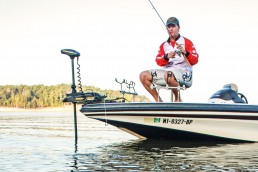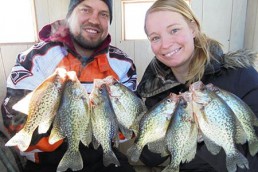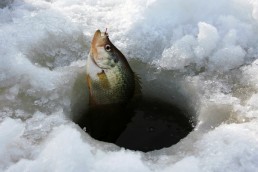Use the Countdown Method to Catch Crappies
SHARE THIS POST
Fishing has become high-tech but the time-tested and productive method of casting still takes crappies. There are few things more fun than retrieving a jig through the right spot and having a crappie slam it.
Where to fish for crappies during fall
Many lakes have fish shelters in the form of small trees, “Christmas trees,” plastic/PVC or some other cover. The cover provides shelter for fish but also create a spot where a fisherman can find them.
Laydowns along a steep bank are great covers. Older trees have fewer small branches, making casting possible. Also, the underwater portion of the tree top in the deepest water is often best.
A graph is good for finding underwater contours and covers. A brushpile sticking up to 10 feet in 18 feet of water is a prime example of a perfect spot for casting. This cover offers good overall depth, with cover available from 10 to 18 feet deep. Crappies can choose a variety of depths but will most likely be positioned in the top of the cover.
Another likely spot is a bend in a creek or river. Wood cover is common in a bend because trees and other wood float in and settle during high water situations.
There are no limits when searching for crappies. Docks, rockpiles and wood all offer potential fishing spots. A key factor is having the right depths.
The countdown crappie fishing method
Countdown casting is very simple. Cast, count the jig down to the magic number and slowly retrieve. The countdown number controls how deep the jig falls before the retrieve begins.
So which number do you use? When casting begins, start with a low number, maybe two. Cast, let the jig fall to a count of two and start the retrieve. If no fish, let the jig fall to a count of four and repeat. Increase the count each time until a fish bites or the bait hangs up on cover. A bite or fish lets you know you are at the right depth. Therefore, a bite at a count of eight means you should repeat that count on the following casts.
The ideal depth will likely be just above the cover. Here is where crappies like to hold and it’s easy for them to come up and take a bait reeled just above the cover. You can let the jig fall into the cover if necessary, but expect a lot of hang-ups. Hang-ups are okay if you are catching fish.
Are you enjoying this post?
You can be among the first to get the latest info on where to go, what to use and how to use it!
Successful baits are often ones with tail action. The most popular is the curly tail jig. It’s basic, simple and has a tail that flutters to attract the attention of a fish. The action makes it look alive. A Southern Pro Hot Grub, Kalin’s Triple Threat and Jenko Big T Curly Fry are examples of good curly tails. A Bobby Garland Stroll’R is a combination of a curly tail and paddle tail. A Charlie Brewer Slider Grub is a mid-sized paddle tail and is a proven crappie catcher.
Using the right jighead for countdown method
Jighead weight is important. A light 1/32-ounce is good for finicky fish and when fishing very shallow or ultra-clear water. A more versatile jig is a 1/16-ounce that provides good casting distance, will drop into deeper water and is easy to control. A 1/8-ounce is good for deep water, fast current or windy conditions. The heavier the jig and deeper the water, the more difficult the control.
Slow and steady. The retrieve is important because it triggers bites and the speed controls depth. A straight, steady rotation of the reel handle creates a basic, but effective, retrieve. In general, crappies prefer a calm presentation. A slow, steady retrieve allows the fishermen to maintain contact with the jig to feel bottom, cover and bites. This is an example of simple being better.
Slow and pause. Another choice is a steady retrieve with an occasional pause. A pause helps keep the bait down in the water and the pause is a triggering action. A fish watching the jig thinks it is an injured minnow. The jig may be hit on the fall or as soon as it takes off again.
Jerk and pause, imparting the proper action to trigger crappies to bite
Jerk and pause. The jerk-pause retrieve is performed by jerking the rod tip up six to 12 inches. The pause allows the jig to fall. While falling, the reel handle is turned very slowly to keep contact with the jig and to bring the jig forward one or two feet before the jerk is repeated. This is a great retrieve when the slow and steady fails to produce.
The countdown method is good when fishing brushpiles, stakebeds and logs, but is also useful when shooting around docks or fishing over piles of rocks. The key is to fish different counts until you find the right depth. After finding the strike zone, repeat the same count each cast.
Another reason to use the countdown method is its simply more fun. A fisherman stays engaged through the whole cast, fall and retrieve process. A fisherman gets to feel the bite and set the hook. Of course, fighting the fish to the boat is fun, too.
Casting a countdown jig is a great way to catch crappies in shallow to mid-depth water. High-tech fishing with multiple poles is very effective, but casting puts fun and the basics of fishing back into focus.
The final tip is to try a weedless jig when crappies are in the cover. A Charlie Brewer Slider jighead has a special design for fishing a crappie jig. It will climb over limbs but allows a hookset when the fisherman gets a bite.
MWO
SHARE THIS POST
Did you enjoy this post?
You can be among the first to get the latest info on where to go, what to use and how to use it!
Tim Huffman
Tim Huffman specializes in crappie fishing, is editor for two crappie magazines, as well as writing for several others. In 2018, he published his sixth book, Limiting Out for Crappie, available at Amazon. His first article appeared in MidWest Outdoors in 1988.



